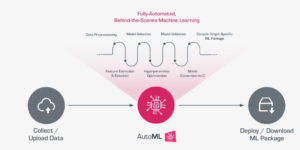

(Dmitriy Rybin/Shutterstock)
Many companies are scrambling to find machine learning engineers who can build smart applications that run on edge devices, like mobile phones. One company that’s attacking the problem in a broad way is Qeexo, which sells an AutoML platform for building and deploying ML applications to microcontrollers without writing a line of code.
Qeexo emerged from Carnegie Mellon University in 2012, just at the dawn of the big data age. According to Sang Won Lee, the company’s co-founder and CEO, the original plan called for Qeexo to be a machine learning application company.
The company landed a big fish, the Chinese mobile phone manufacturer Huawei, right out the gate. Huawei liked the ML-based finger-gesture application that Qeexo (pronounced “Key-tzo”) developed, and the company wanted Qeexo to ensure that it could run across all of its phone lines. That was a good news-bad news situation, Lee says.
“Our first commercial implementation with Huawei kept the whole company in China for two months, to finish one model with one hardware variant,” Lee tells Datanami. “We came back and it was difficult to keep the morale high for our ML engineers because nobody wanted to constantly go abroad to do this type of repetitive implementation.”
It quickly dawned on Lee that, with more ML models and more hardware types, the amount of manual work would quickly get out of hand. That led him to the idea of developing an automated machine learning, or AutoML, platform that could automatically generate ML models based on the data presented to it, automatically “flash” it to a group of pre-selected microcontrollers.
Lee and his team of developers, which is led by CTO and co-founder Chris Harrison (who is an assistant professor at Carnegie Mellon University), developed the offering nearly five years ago, and the company has been using it ever since for its own ML services engagements.
Huawei continues to utilize Qeexo’s AutoML solution to generate ML applications for its handsets. “In 2018, we completed 57 projects for Hauwei, and most of the projects were completed by our field engineers just using the AutoML platform, without the help of ML engineers in the US,” Lee says.
In October 2019, Qeexo released its AutoML offering as a stand-alone software offering. The product automates many steps in the ML process, from building models from collected data, comparing performance of those models, and then deploying the finished model to a microcontroller – all without requiring the user to write any code.
The offering has built-in support for the most popular ML algorithms, including random forest, gradient boosted machine, and linear regression, among others. Users can also select deep learning models, like convolutional neural networks, but many microcontrollers lack the memory to handle those libraries, Lee says.
Qeexo’s AutoML solution automatically handles many of the engineering tasks that would otherwise require the skills of a highly trained ML engineer, including feature selection and hyperparameter optimization. These feature are built into the Qeexo offering, which also sports a built-in C compiler and generates binary code that can be deployed to microcontrollers, such as those from Renasas Electronics.
Lee says ML engineers might be able to get a little more efficiency by developing their own ML libraries, but that it won’t be worth the effort for many users. “There are always more improvements that you can get with ML experts digging into it and doing the research,” he says. “But this is giving you the convenience of being able to build a commercially viable solution without having to write a single line of code.”
Today Qeexo announced its new AWS solution. Instead of training a model on a laptop, customers can use now AWS resources to train their model. It also announced more ML algorithms, including deep learning algorithms and “traditional” algorithms. The visualization that Qeexo provides have also been enhanced to give the user the ability to better spot outliers and trends in data. Support for microphone data has been supported. And it also added support for the Renesas RA Family of Cortex-M MCUs, which are geared toward low-power IoT edge devices.
Having Huawei as a client certainly gives Qeexo some experience with scalability under its belt. But the Mountain View, California-based company is bullish on the potential for a new class of application developers to get started using its software to imbue everyday devices with the intelligence of data.
“What we really want to tell the market is that even or those microcontrollers that are already out and that have very limited memory resource and processing power, you can still have a commercially viable ML solution running on it, if you use the right tool,” Lee says. “You don’t want to neglect all the sensor data that’s connected to the microcontroller. We can provide a tool that you can use to build intelligence that can be embedded into those tools.”
Related Items:
On the Radar: Cortex Labs, RadicalBit, Qeexo
AutoML Tools Emerge as Data Science Difference Makers
Cloud Tools Rev Up AI Dev Platforms
January 8, 2025
- Centific Integrates NVIDIA AI Blueprint to Advance Video Analytics Across Industries
- JEDEC Announces Updates to Universal Flash Storage and Memory Interface Standards
- Securonix Named a Customers’ Choice in 2024 Gartner Peer Insights for SIEM
- Cloudinary Named a Visionary in 2024 Gartner Magic Quadrant for Digital Asset Management Platforms
- Oracle Unveils Exadata X11M with Performance Gains Across AI, Analytics, and OLTP
- NVIDIA and Partners Launch Agentic AI Blueprints to Automate Work for Every Enterprise
- SymphonyAI Advances Next-Gen Connected Retail with Microsoft Azure Open AI Service at NRF 2025
January 7, 2025
- Accenture Launches AI Refinery for Industry to Accelerate AI Agent Deployment
- Domo Partners with Data Consulting Group to Provide Advanced BI Capabilities to Global Enterprises
- NVIDIA Unveils Project DIGITS Personal AI Supercomputer
- IBM Study: AI Spending Expected To Surge 52 Percent Beyond IT Budgets
- Exabeam Enhances SOC Efficiency with New-Scale Platform’s Open-API Integration
- SEMI Report: 18 New Semiconductor Fabs to Start Construction in 2025
- GIGABYTE Launches New Servers with NVIDIA HGX B200 Platform for AI and HPC
January 6, 2025
- O’Reilly 2025 Tech Trends Report Reveals AI Skills Surge While Security Governance Takes Center Stage
- Marvell Unveils Co-Packaged Optics for Custom Processors to Boost AI Server Interconnects
- Qlik Recognized with Customers’ Choice Distinction for Analytics and Business Intelligence Platforms
December 20, 2024
- Reltio Recognized as Best-of-Breed Representative Vendor in 2024 Gartner Market Guide for Master Data Management Solutions
- CapStorm Releases Salesforce Connector Offering Seamless Data Integration with Snowflake
- LogicMonitor and AppDirect Partner to Bring Hybrid Observability Solutions to IT Service Providers





























